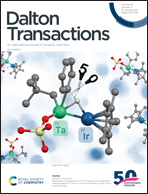Complexes of Th(iv) with neutral O–N–N–O hybrid ligands: a thermodynamic and crystallographic study†
Abstract
The thermodynamics of Th(IV) complexes with N,N,N′,N′-tetramethyl-2,2′-bipyridine-6,6′-dicarboxamide (TMBiPDA) and N,N,N′,N′-tetramethyl-1,10-phenanthroline-2,9-dicarboxamide (TMPhenDA) in CH3OH/10%(v)H2O (CH3OH : H2O = 9 : 1 by volume) were determined by spectrophotometry and calorimetry. The ligand TMBiPDA/TMPhenDA coordinates with the central Th atom by the tetradentate (O–N–N–O) mode, which is validated by 1H NMR in solution and crystallography in the solid. The single crystal X-ray diffraction data show that ten-coordinated thorium coordinates with two ligand molecules and two solvent molecules (water or methanol). Both ThL and ThL2 complexes (L = TMPhenDA or TMBiPDA) were detected in solution. In thermodynamics, the formation of all complexes is driven by both enthalpy and entropy. In a comparison, enthalpy is more favorable to the formation of TMBiPDA complexes, while entropy is more favorable to the formation of TMPhenDA complexes; the entropy advantages of the TMPhenDA complexes override the enthalpy advantages of the corresponding TMBiPDA complexes, giving the TMPhenDA complexes higher stability constants than the TMBiPDA complexes. In crystallography, ligand distortions occur in ThL2 complexes, and TMBiDA distorts more than TMPhenDA does; the Th–O and Th–N bonds involving TMBiPDA are slightly shorter than those involving TMPhenDA.



 Please wait while we load your content...
Please wait while we load your content...